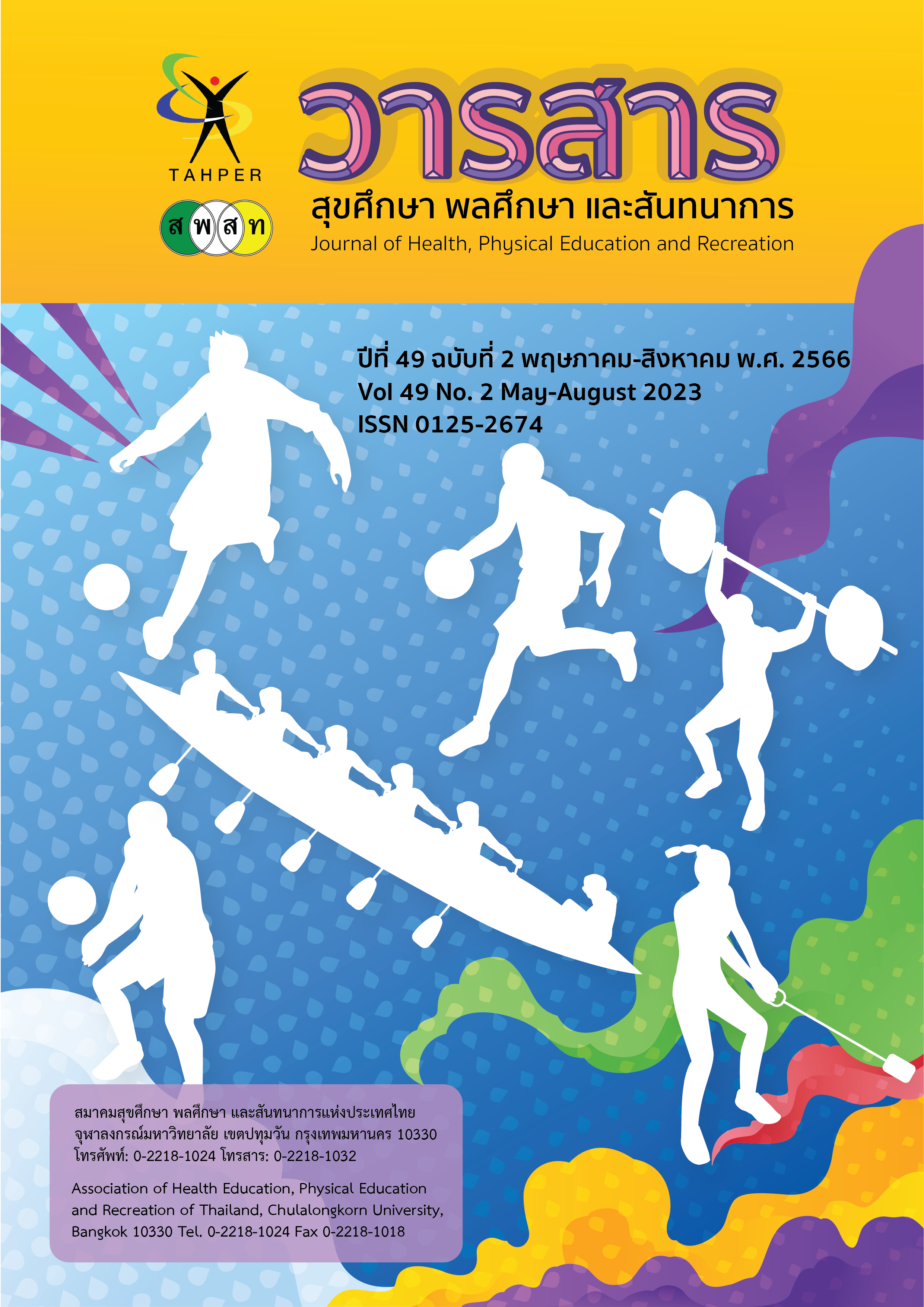Effects of Physical Education Learning Management Using Active Learning on Learning Achievement and Problem Solving Abilities of Eighth Grade Students
Main Article Content
Abstract
The purpose of this study were 1) to compare the average scores of learning achievements and problem solving ability before and after the experiment of students in experiment group who received the Active Learning in physical education management program and the control group who received the normal physical education instruction program. 2) to compare the average scores of learning achievement and problem solving ability of students in the experimental group and the control group after finish the program. The participants were 68 students in Matthayom 2. Students were be Simple Random Sampling. The participants were divided into 2 groups. There are 34 students in experimental group and 34 students in control group. The experiment was conducted for 8 weeks, 1 day per week, 60 minutes per day. The research instruments are 1) the active learning lesson plan, there were 8 lesson plans with the IOC equal to 0.90 2) physical education achievement measurement with the IOC equal to 0.96 3) problem solving ability measurement with the IOC equal to 1.00 The data was analyzed by Means, Standard Deviations and t-test. The result of the research shows that : 1) the average scores of learning achievement and problem solving ability after the experiment of experimental group was higher than before the experiment at the significance level of .05 2) the average scores of learning achievement and problem solving ability after the experiment of experimental group was higher than the control group at the significance level of .05 Conclusion : Physical education learning management with using active learning concepts could improve learning achievement and problem solving ability of Matthayom 2 students.
Article Details

This work is licensed under a Creative Commons Attribution-NonCommercial-NoDerivatives 4.0 International License.
Critical thinking in journals is the right of the author. The Association of Health Education, Physical Education and Recreation of Thailand is not always required, to create diversity in ideas and creativity.
ความคิด ข้อวิพากษ์ในวารสารเป้นสิทธิของผู้เขียน สมาคมสุขศึกษา พลศึกษา และสันทนาการแห่งประเทศไทยไม่จำเป็นต้องเห็นชอบด้วยเสมอไป เพื่อให้เกิดความหลากหลายในความคิดและความสร้างสรรค์
References
กระทรวงศึกษาธิการ. (2562). กลุ่มพัฒนาระบบฐานข้อมูลและสารสนเทศเพื่อการศึกษา. กรุงเทพฯ: ศูนย์เทคโนโลยีสารสนเทศและการสื่อสาร สำนักปลัดกระทรวงศึกษาธิการ
จตุพร สุทธิรัตน์. (2550). การพัฒนาการเรียนการสอนกลุ่มสาระการเรียนรู้สุขศึกษาและพลศึกษา (พลศึกษา) ชั้นประถมศึกษาปีที่ 6 ปีการศึกษา 2550 โรงเรียนเทศบาล บ้านเขานิเวศน์ จังหวัดระนอง. Silpakorn Educational Research Journal, 6(2). 233-245.
ไฉน รัตนภักดี. (2544). เจตคติที่มีต่อวิชาพลศึกษาของนักเรียนชั้นมัธยมศึกษาปีที่ 6 ในจังหวัดประจวบคีรีขันธ์. วิทยานิพนธ์ปริญญาศิลปศาสตรมหาบัณฑิต สาขาวิชาพลศึกษามหาวิทยาลัยเกษตรศาสตร์.
นนทลี พรธาดาวิทย์. (2559). การจัดการเรียนรู้แบบ Active Learning. กรุงเทพฯ: ทริปเพิ้ล เอ็ดดูเคชั่น.
พุทธรัตน์ พุทธจำ. (2558). การนำเสนอแนวทางการจัดการเรียนรู้พลศึกษาในโรงเรียนระดับชั้นประถมศึกษา สังกัดกรุงเทพมหานคร. An Online Journal of Education, 10(2), 382-396.
วรศักดิ์ เพียรชอบ. (2548). รวมบทความเกี่ยวกับปรัชญา หลักการ วิธีสอน และการวัดเพื่อประเมินผลทางพลศึกษา. กรุงเทพฯ: สำนักพิมพ์แห่งจุฬาลงกรณ์มหาวิทยาลัย.
วัฒนาพร ระงับทุกข์. (2542). การจัดการเรียนการสอนที่เน้นผู้เรียนเป็นศูนย์กลาง. กรุงเทพฯ: เลิฟแอนด์เลิฟเพรส
วิจารณ์ พานิช. (2555). วิถีสร้างการเรียนรู้เพื่อศิษย์ในศตวรรษที่ 21. กรุงเทพฯ: มูลนิธิสดศรี-สฤษดิ์วงศ์.
สมบูรณ์ อินทร์ถมยา. (2547). การพัฒนาเครื่องมือวัดปัญญาด้านการรับรู้ภาวการณ์เคลื่อนไหวของร่างกาย. วิทยานิพนธ์ครุศาสตรดุษฎีบัณฑิต สาขาวิชาพลศึกษา, จุฬาลงกรณ์มหาวิทยาลัย.
อมรเทพ คำเพชร. (2560). การศึกษามโนทัศน์และผลสัมฤทธิ์ทางการเรียนวิชาพลศึกษา กลุ่มสาระการเรียนรู้สุขศึกษาและพลศึกษา ของนักเรียนชั้นมัธยมศึกษาปีที่ 1 เรื่องการฝึกทักษะกีฬาเปตอง. สืบค้น 28 ธันวาคม 2562, จาก http://www.kroobannok.com/board_view.php?b_id=165163
Killian, & Batas (2015) The Effects of an Active Learning Strategy on Studentss’ Attitude and Students’ Performances in Introductory Socialogy Classes. Journal of the Scholarship of Teaching and Learning, 15. 53-67.


